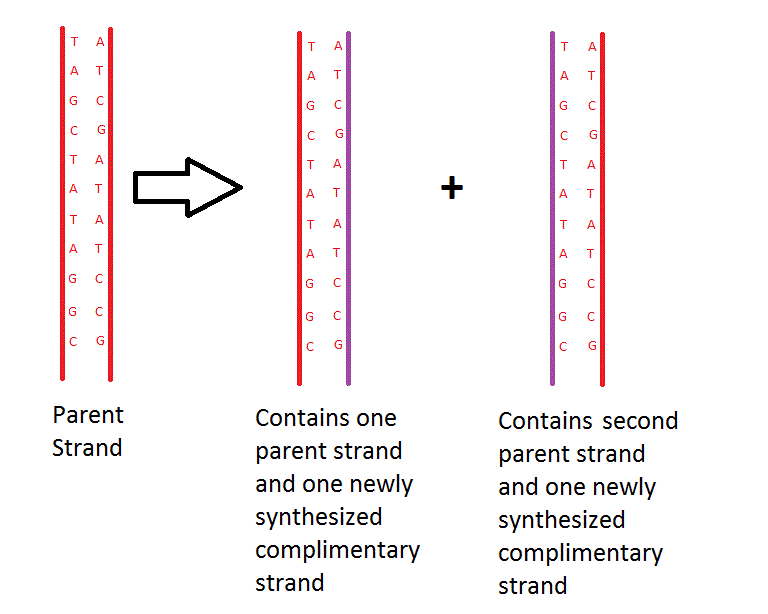Semi-conservative replication: Difference between revisions
No edit summary |
m added text |
||
| (5 intermediate revisions by 4 users not shown) | |||
| Line 1: | Line 1: | ||
Semi-conservative replication is the mechanism by which [[DNA|DNA]] replicates in [[Cell|cells]]. The | Semi-conservative replication is the mechanism by which [[DNA|DNA]] replicates in [[Cell|cells]]. The double stranded DNA unwinds, hydrogen bonds are broken between the two strands by the enzyme DNA helicase. One of the strands is used as a template to form a second [[Complementary strand|complementary strand]]. The exposed bases on the single-stranded DNA complementary base pair to [[Nucleotides|nucleotides]]. A ([[Adenine|Adenine]]) pairs with T ([[Thymine|Thymine]]) and C ([[Cytosine|Cytosine]]) pairs with G ([[Guanine|Guanine]])<ref>Alberts et al. Molecular biology of the cell fifth edition 2007. Page 266</ref>. Together the template strand and the complementary strand bond together to form a new double strand of DNA using the enzyme DNA polymerase. One parent double strand of DNA will thus become two daughter double strands of DNA<ref>Hartl, D and Jones, E (2009). Genetics- Analysis of genes and genomes. 7th ed. Sudbury: Jones and Bartlett Publishers, Inc. 192.</ref>, each consisting of a strand from the template and a newly formed strand. | ||
The term "semi-conservative" refers to the fact that each of daughter double | The new strand of [[DNA|DNA]] is made in the 5' to 3' direction as a deoxyribonucleotide is added to the 3' OH end of the chain which is catalysed by [[DNA polymerase|DNA polymerase]]<ref>Alberts et al. Molecular biology of the cell fifth edition, 2007. Page 268</ref>. | ||
The term "semi-conservative" refers to the fact that each of the daughter double helixes contains one conserved strand from the parent DNA, as well as one newly synthesised strand<ref>http://www.nature.com/scitable/topicpage/Semi-Conservative-DNA-Replication-Meselson-and-Stahl-421</ref>.[[Image:Semi-conservative replication.gif]] | |||
=== References === | === References === | ||
<references /> | <references /> | ||
Latest revision as of 13:39, 9 December 2018
Semi-conservative replication is the mechanism by which DNA replicates in cells. The double stranded DNA unwinds, hydrogen bonds are broken between the two strands by the enzyme DNA helicase. One of the strands is used as a template to form a second complementary strand. The exposed bases on the single-stranded DNA complementary base pair to nucleotides. A (Adenine) pairs with T (Thymine) and C (Cytosine) pairs with G (Guanine)[1]. Together the template strand and the complementary strand bond together to form a new double strand of DNA using the enzyme DNA polymerase. One parent double strand of DNA will thus become two daughter double strands of DNA[2], each consisting of a strand from the template and a newly formed strand.
The new strand of DNA is made in the 5' to 3' direction as a deoxyribonucleotide is added to the 3' OH end of the chain which is catalysed by DNA polymerase[3].
The term "semi-conservative" refers to the fact that each of the daughter double helixes contains one conserved strand from the parent DNA, as well as one newly synthesised strand[4].
References
- ↑ Alberts et al. Molecular biology of the cell fifth edition 2007. Page 266
- ↑ Hartl, D and Jones, E (2009). Genetics- Analysis of genes and genomes. 7th ed. Sudbury: Jones and Bartlett Publishers, Inc. 192.
- ↑ Alberts et al. Molecular biology of the cell fifth edition, 2007. Page 268
- ↑ http://www.nature.com/scitable/topicpage/Semi-Conservative-DNA-Replication-Meselson-and-Stahl-421